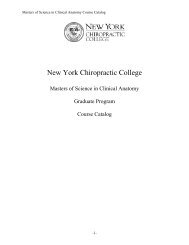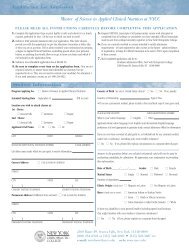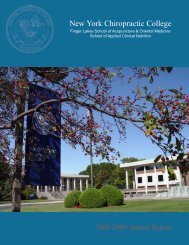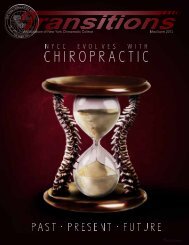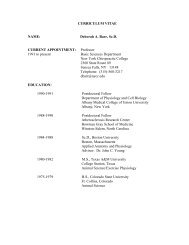2502 NYCC TRANS FINAL2 - New York Chiropractic College
2502 NYCC TRANS FINAL2 - New York Chiropractic College
2502 NYCC TRANS FINAL2 - New York Chiropractic College
Create successful ePaper yourself
Turn your PDF publications into a flip-book with our unique Google optimized e-Paper software.
From Mighty Mice to Healthy Humans<br />
Discovered Protein Fragment Causes Muscles<br />
to Burn Fat at High Rate<br />
The Proceedings of the National Academy of Sciences reported a study<br />
about obese mice losing weight irrespective of the amount of food<br />
they ate. What’s more, their food contained lots of fat and<br />
calories.<br />
Harvey Lodish of the Whitehead Institute for<br />
Biomedical Research, who teaches at<br />
Massachusetts Institute of Technology,<br />
discovered a protein normally secreted by<br />
human fat cells called Acrp 30. When he<br />
isolated a fragment of the protein called<br />
gAcrp30 and injected it into obese mice, it<br />
resulted in weight loss. It appears the fragment<br />
works by forcing muscles to burn fatty acids at a<br />
high rate rather than storing them as fat cells.<br />
What promise does this hold for obese people?<br />
Dr. Lodish is cautiously optimistic, though<br />
some challenges remain. Since<br />
gAcrp30 is a protein, and proteins<br />
taken orally are usually destroyed when<br />
digested, injection is the only current<br />
means by which it is introduced<br />
successfully into the system.<br />
Protein Discovered That Prevents<br />
Fat Cell Formation<br />
Man’s efforts to thwart encroaching flab were highlighted by a<br />
research team at the University of Michigan, according to the journal<br />
Science. Graduate student Sarah Ross led the study, isolating a<br />
protein that stops precursor cells from becoming fat cells. The protein<br />
Wnt-10b essentially functions as a “fat switch” that tells a cell not<br />
to become a fat cell — thereby allowing the cell instead to become<br />
lean muscle. Thus far, only mice have found the team’s findings<br />
useful.<br />
Obese Men Lose<br />
Abdominal Fat With CLA’s<br />
The International Journal of Obesity reports that obese men who<br />
ingested conjugated linoleic acid (CLA) experienced significant abdominal<br />
fat reduction. A four-week study involved 24<br />
obese men between the ages of 39 and 64. Some men<br />
were given a daily dose of 4.2 grams of CLA, while<br />
others received a placebo. The CLA group had significant<br />
waistline reduction while the placebo group<br />
did not. What’s more, the CLA group experienced no<br />
increased cardiovascular risk factors. CLA’s are found<br />
naturally in red meat, lamb and dairy products, and<br />
CLA supplements are commonly sold in health<br />
stores.<br />
CLA’s discovery was a fortuitous<br />
happenstance. Michael Pariza, a<br />
University of Wisconsin-Madison<br />
food scientist, isolated CLA in<br />
1987 as he looked for a chemical<br />
in burned hamburger that appeared<br />
to prevent cancer in lab animals.<br />
Students caring for Pariza’s<br />
lab animals noticed that although<br />
the animals that ingested CLA were<br />
growing faster than normal, they<br />
were eating less<br />
than usual. More specifically, a diet<br />
containing 0.5 percent CLA reduced body fat in mice and<br />
other lab animals by 50 to 75 percent, yet increased the amount of<br />
muscle.<br />
CLA battles the bulge by interfering with an enzyme called lipoprotein<br />
lipase that the body uses to move fat from the blood into fat<br />
cells, and that would otherwise have made the fat cells fatter. It also<br />
enhances the enzyme hormone-sensitive lipase — breaking down fat<br />
within fat cells and making it possible for muscles to burn it. Hog<br />
and steer producers have found that introduction of CLA into their<br />
animals’ feed will result in leaner cuts of meat.<br />
Researchers Isolate Enzyme That Regulates Fat Burning<br />
Researchers at Houston’s Baylor <strong>College</strong> of Medicine<br />
found that when an enzyme called acetyl-CoA carboxylase 2<br />
(ACC2) is blocked in mice, they can eat a lot more food than<br />
other mice and still weigh 10 to 15 percent less! ACC2<br />
activates Malynyl CoA, an enzyme found largely in skeletal<br />
and cardiac muscle and known to regulate fat metabolism.<br />
Whenever the enzyme is suppressed, fat is burned rather than<br />
stored. As a result, the researchers are now looking into<br />
compounds to be used in a pill for humans that would block<br />
secretion of ACC2.<br />
www.nycc.edu<br />
21



